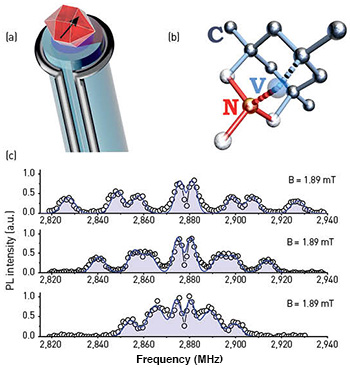 (a) An optical fiber integrated with a two-wire microwave transmission line and a nitrogen-vacancy (NV) diamond microcrystal at the fiber tip. (b) Four possible arrangements of the NV axis in the diamond crystal lattice. (c) Intensity of photoluminescence from NV centers as a function of the frequency of the microwave field inducing the electron spin resonance in the presence of a variable magnetic field B applied along the axis of the optical fiber. Circles, experiments; solid line, simulations.
(a) An optical fiber integrated with a two-wire microwave transmission line and a nitrogen-vacancy (NV) diamond microcrystal at the fiber tip. (b) Four possible arrangements of the NV axis in the diamond crystal lattice. (c) Intensity of photoluminescence from NV centers as a function of the frequency of the microwave field inducing the electron spin resonance in the presence of a variable magnetic field B applied along the axis of the optical fiber. Circles, experiments; solid line, simulations.
The electron spin of nitrogen-vacancy (NV) centers in diamond offers a unique solid-state system for quantum science and technology, allowing the creation of efficient and stable solid-state single-photon sources and opening unprecedented opportunities for bioimaging, highly sensitive nanoscale magnetometry, and thermometry of single living cells.1–4 To unleash the full potential of these emerging devices and make them entirely compatible with the requirements of practical quantum technologies and in vivo studies in life sciences, NV-diamond quantum sensors have to be integrated with fiber optic probes.
We have demonstrated an ultracompact fiber optic probe where a diamond microcrystal with a well-defined orientation of spin quantization NV axes is attached to the fiber tip, allowing the electron spins of NV centers to be manipulated, polarized and read out through a fiber optic waveguide integrated with a two-wire microwave transmission line.5 The electron spin of NV centers in a diamond microcrystal attached to the tip of the fiber probe is manipulated by a frequency-modulated microwave field transmitted through the two-wire transmission line, which is short-circuited with a loop, winding around the fiber tip, inducing a microwave field distribution with a maximum at the location of diamond microcrystal.
The electron spin is then optically polarized, initialized and read out by laser radiation transmitted through the optical tract of the fiber probe. The photoluminescence spin-readout return from NV centers is captured and delivered by the same optical fiber. The magnetic field can then be determined from the positions of the electron-spin resonance peaks in the spectrum of the photoluminescence signal measured as a function of the microwave frequency. Such a fiber probe, integrated with an NV-diamond quantum sensor and a microwave transmission line, allows high-sensitivity, high-speed imaging of magnetic fields and offers a unique tool for a thermometry of individual biological cells in in vivo experiments.
Researchers
I.V. Fedotov, A.A. Voronin, D.A. Sidorov-Biryukov and A.B. Fedotov, International Laser Center, Lomonosov Moscow State University, Russia (ILC MSU), and the Russian Quantum Center (RQC)
L.V. Doronina-Amitonova, ILC MSU, RQC, and Kurchatov Institute National Research Center, Russia
A.M. Zheltikov, ILC MSU, RQC, and Texas A&M University, USA
A.O. Levchenko, V.L. Velichansky and S.A. Zibrov, Lebedev Physical Institute, Russian Academy of Sciences
References
1. M.G. Dutt et al. Science 316, 1312 (2007).
2. D. Le Sage et al. Nature 496, 486 (2013).
3. G. Balasubramanian et al. Nature 455, 648 (2008).
4. G. Kucsko et al. Nature 500, 54 (2013).
5. I.V. Fedotov et al. Sci. Reports 4, 5362 (2014).
